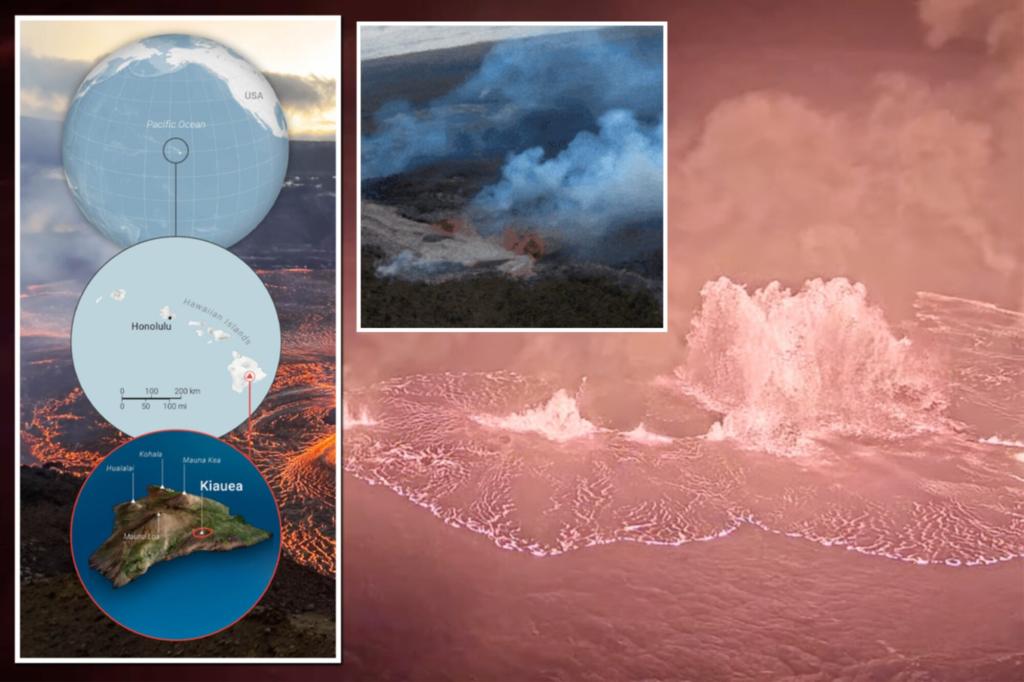Paragraph 1: The Reawakening of Kilauea
Kilauea, a name synonymous with volcanic dynamism, has once again stirred from its slumber. Located on the Big Island of Hawaii, this highly active volcano resumed its eruptive activity in the early hours of Monday, captivating scientists and onlookers alike. The Hawaiian Volcano Observatory (HVO), tasked with monitoring Kilauea’s every tremor and exhalation, confirmed the eruption’s commencement, promptly raising the volcano alert level to its highest designation, signaling the potential for significant volcanic hazards. The eruption’s initial stages, characterized by unpredictable shifts and surges in activity, unfolded within the confines of Halemaʻumaʻu crater, nestled within the larger summit caldera known as Kaluapele, a closed area within Hawai’i Volcanoes National Park. This restricted access ensures the safety of the public while allowing scientists to closely observe the volcano’s evolving behavior.
Paragraph 2: A Fiery Spectacle Within the Caldera
The eruption’s dramatic opening act painted a vivid spectacle against the backdrop of the Hawaiian night. Webcam imagery, a crucial tool for remote monitoring, revealed a line of fissures tearing open the Earth’s surface within Halemaʻumaʻu. From these fiery cracks, lava fountains jetted skyward, their molten streams cascading down the crater’s slopes, feeding burgeoning lava flows. The confined nature of the eruption within the summit caldera, a vast bowl-shaped depression at the volcano’s summit, offered a degree of containment, limiting the immediate threat to surrounding areas. However, the inherent dynamism of volcanic eruptions necessitates constant vigilance, as the situation can rapidly evolve.
Paragraph 3: The Invisible Threat: Volcanic Gases
While the incandescent lava flows command attention, a less visible but equally significant hazard accompanies Kilauea’s eruption: volcanic gases. These gaseous emissions, primarily composed of water vapor, carbon dioxide, and sulfur dioxide, pose a significant health risk. Sulfur dioxide, a pungent, colorless gas, can react with atmospheric moisture and sunlight to form volcanic smog, also known as vog. Vog can blanket vast areas downwind of the eruption, reducing visibility and posing respiratory challenges, particularly for individuals with pre-existing respiratory conditions. Carbon dioxide, while odorless and colorless, can displace oxygen in low-lying areas, creating a suffocation hazard.
Paragraph 4: Ash and Particulates: Irritants in the Air
In addition to the gaseous emissions, volcanic eruptions can release fine ash and other particulate matter into the atmosphere. These microscopic particles, carried by the wind, can travel considerable distances, posing health risks to both humans and animals. Skin and eye irritation are common complaints associated with exposure to volcanic ash. Individuals with respiratory sensitivities may experience exacerbated symptoms, such as coughing, wheezing, and shortness of breath. Precautions, such as wearing protective masks and limiting outdoor exposure, are crucial for mitigating the potential health impacts of volcanic ash.
Paragraph 5: Monitoring and Mitigation: A Collaborative Effort
The HVO maintains continuous surveillance of Kilauea, employing a network of seismometers, GPS stations, and gas monitoring instruments to track the volcano’s activity and forecast potential hazards. This real-time data informs public safety advisories and guides emergency response efforts. Collaboration between scientific agencies, emergency management officials, and local communities is essential for ensuring public safety during volcanic eruptions. Public education campaigns play a vital role in disseminating information about volcanic hazards and promoting preparedness measures.
Paragraph 6: Kilauea’s Legacy: A Force of Nature
Kilauea’s eruptive history serves as a reminder of the raw power of nature. The volcano’s frequent eruptions have shaped the landscape of the Big Island, creating new land while simultaneously posing challenges to human settlements. Understanding Kilauea’s behavior is crucial for mitigating the risks associated with its eruptions and coexisting with this dynamic force of nature. The ongoing eruption underscores the importance of scientific monitoring, public awareness, and community preparedness in navigating the challenges posed by volcanic activity.

